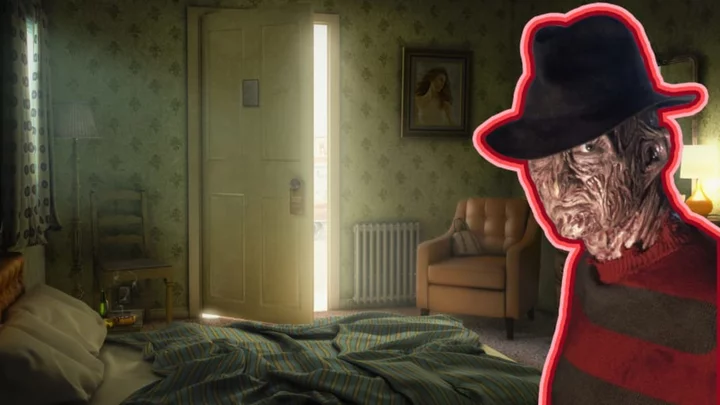In 1981, Wes Craven needed a hit.
He’d been making movies for about 15 years by then and he’d already directed two films that are now regarded as horror classics: 1972’s The Last House on the Left and 1977’s The Hills Have Eyes. But he was earning a living as a director for hire, making TV movies like the 1978 Lois Duncan adaptation, Summer of Fear. He jumped at the chance to make two features, Deadly Blessing (1981) and Swamp Thing (1982), back-to-back. While those films fizzled at the box office, they gave him the funds he needed to take a few months off and write a script he thought might turn things around.
Elements of that script—about a killer who stalked his victims in their dreams—had been percolating in Craven’s brain for years, but it took news reports of a string of bizarre deaths to finally get him writing.
“The Hundred Years’ Enigma”
Throughout 1981, the Los Angeles Times ran a series of articles about otherwise healthy Laotian refugees who had mysteriously died in their sleep, apparently after experiencing violent nightmares. Most of the victims were men in their thirties, and many were from the Hmong community, an ethnic group that had emigrated from its native China to Vietnam, Laos, and Thailand in the 19th century. Thousands of its members then relocated to the U.S. after the Vietnam War ended in 1975.
An Associated Press story from December 1981 reported that “[a]n unexplained affliction is killing Laotian refugees at an extremely high rate, striking its victims quickly and without warning while they sleep ... ” There were reports of 38 such cases occurring between July 1977 and October 1981. By the end of December 1981, the Centers for Disease Control and Prevention’s Mortality and Morbidity Weekly Report had linked these “Sudden, unexpected, nocturnal deaths among Southeast Asian refugees” to a phenomenon more succinctly known as “SUNDS.”
“It is a completely new syndrome,” declared Dr. Roy Baron, an epidemiologist with the CDC. “Death in young, healthy people that occurs at night, that occurs in minutes, and lacks explanation after autopsy.”
Baron was wrong about one thing: The affliction that would come to be known as SUNDS wasn’t new. As far as we know, it was first described by a Filipina doctor in a 1917 Spanish medical journal; in 2018, a paper published in the Journal of the American Heart Association called SUNDS “the hundred years’ enigma.” Similar deaths had been reported in China, the Philippines, Thailand, Hawaii, Japan, and England, under a variety of names. In the Philippines, the phenomenon is known as bangungut, a word the International Journal of Epidemiology translates as “to rise and moan during sleep.” In Hawaii, it’s reportedly known as “dream disease.”
But the cases that stirred Craven’s imagination and helped inspire 1984’s A Nightmare on Elm Street were part of a rash of deaths that were mostly confined to America’s Hmong communities. By the time the outbreak apparently ended in the late ’80s, SUNDS had claimed at least 117 lives. All but one known victim was male, and many were Hmong men who had fled Laos after the Vietnam War to escape persecution under the country’s communist government. In February 1981, an LA Times article speculated that a “nightmare syndrome” was killing the men. In July, the paper ran a headline declaring “Men of Hmong Dogged by Death.” (If you’re keeping track of the timeline, this would have been published just after Craven wrapped production on Swamp Thing in South Carolina, shortly before he’d go on his Elm Street sabbatical.)
Several possible causes were suggested, but all were dead ends, and autopsies didn’t reveal any physiological clues. Some wondered if the answer might lie in the conditions that had led the men to the United States in the first place.
A ‘Secret War’
While the American military was fighting communist forces in Vietnam, the CIA was conducting what’s been called a “secret war” in neighboring Laos. Hmong people were integral to that effort: They were recruited and trained by the CIA to fight, gather intelligence, protect American assets, and rescue American pilots who’d been shot down over Laotian jungles.
The results were devastating for the Hmong, who suffered tens of thousands of casualties during the fighting, as well as during their subsequent efforts to escape brutal persecution after America’s withdrawal from the conflict in 1975. Many made their way to the U.S. after spending time in refugee camps in Thailand and formed tight-knit communities in California, Wisconsin, Minnesota, and Oregon.
Some attributed the puzzling deaths to chemical weapons the men would have been exposed to during the prolonged warfare in Laos and Cambodia, but proponents of that theory couldn’t explain why the chemicals had taken several years to kill them, or why the deaths only occurred at night.
But many Hmong elders had another theory: The deaths, they said, were the work of the dab tsog, a malevolent spirit believed to attack and suffocate victims while they slept.
The dab tsog operates a lot like the Old Hag of European folklore. It’s part of a taxonomy of beings sometimes known as “pressing spirits” for their habit of squeezing the breath out of their victims—not exactly melted-face-and-knife-glove territory, but terrifying enough for anyone who encounters one in their sleep. Researchers have linked these folktales to sleep paralysis, an experience that leaves sufferers unable to speak or move, but often utterly convinced that a sinister presence is lurking just out of view.
The theory that an evil spirit was killing Hmong men in their sleep obviously didn’t gain much traction in the medical community, which continued to search for a physiological explanation. Years later, though, a more nuanced understanding of the power of belief has led at least one researcher to a startling conclusion: In a manner of speaking, the Hmong elders were right.
“A Fatal Power of the Imagination”
In 2011, Dr. Shelley Adler, director of education at the Osher Center for Integrative Medicine at the University of California, San Francisco, published a book called Sleep Paralysis: Nightmare, Nocebos, and the Mind-Body Connection. She had spent 15 years conducting field research on the Hmong sleep deaths and combing through archival records, and she had become convinced that, while an evil spirit hadn’t killed the men, their belief in it did.
Adler argued that the SUNDS deaths were a prime example of the nocebo effect, which is the dark flipside of the better-known placebo effect. Placebo takes its name from a Latin phrase meaning “I shall please,” while nocebo’s Latin antecedent translates as “I will be harmful.” When we experience the placebo effect, a treatment with no real medical value improves our condition, often in measurable ways, because we think it will. With nocebo, the opposite is true: Something that can’t really hurt us, such as a mythical demon that supposedly haunts our sleep, could become physically harmful or even fatal if our belief in it is strong enough.
Adler isn’t the first researcher to study the phenomenon; in 1942, prominent American physiologist Walter Cannon wrote about what he called “voodoo death,” where people in Africa, South America, and Australia died after believing they’d been cursed. Cannon described it as “a fatal power of the imagination working through unmitigated terror.”
During her research, Adler found that, while experiences interpreted as dab tsog attacks were common in Laos, they were rarely (if ever) fatal. So why had the dab tsog supposedly become a killer in America? Adler attributes the shift to the fact that, in Laos, there was a cultural infrastructure in place to process the experiences. Sufferers could talk about what was happening to them without stigma, consult shamans, and avail themselves of rituals they believed would dispel the spirit.
Hmong people who had settled in America, on the other hand, had no such support network. Shamans were not as readily available in American Hmong communities, and even if one could be located, the curative rituals often involved animal sacrifice or other elements that were forbidden in the U.S. Besides that, some of the most basic functions of traditional Hmong society were upended in America: Hmong men were expected to provide for their families and honor their ancestral spirits, but they had trouble supporting their families in America and had to rely on either social services or other family members, including women, for help. According to Adler, all of these factors made Hmong men who had immigrated to America feel especially vulnerable to the predations of a dream killer.
Craven probably wasn’t aware of much of this, but the stories he read were enough to help him conjure up a different kind of demon—and invent one of the most iconic screen villains in cinema history.
“I just turned these occurrences around and asked, ‘What if the death was a result of the dream?’” he told Rolling Stone in 1988. “‘What if the dreams were actually killing these men? And what if they were all sharing a common frightening dream?’ So I started constructing a villain that existed only in dreams.”
This article was originally published on www.mentalfloss.com as ‘Dogged by Death’: The True Story Behind the Bizarre Syndrome That Inspired ‘A Nightmare on Elm Street’.









